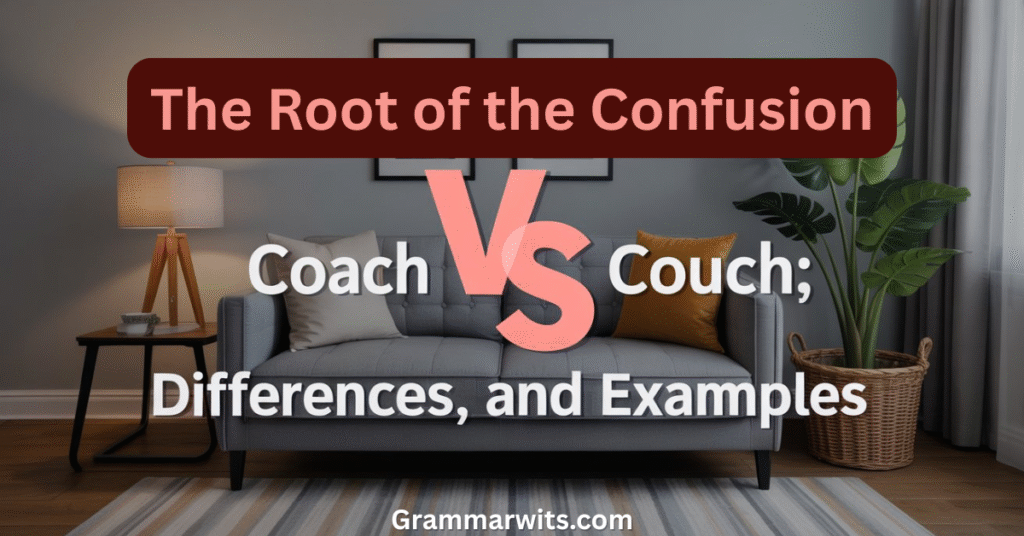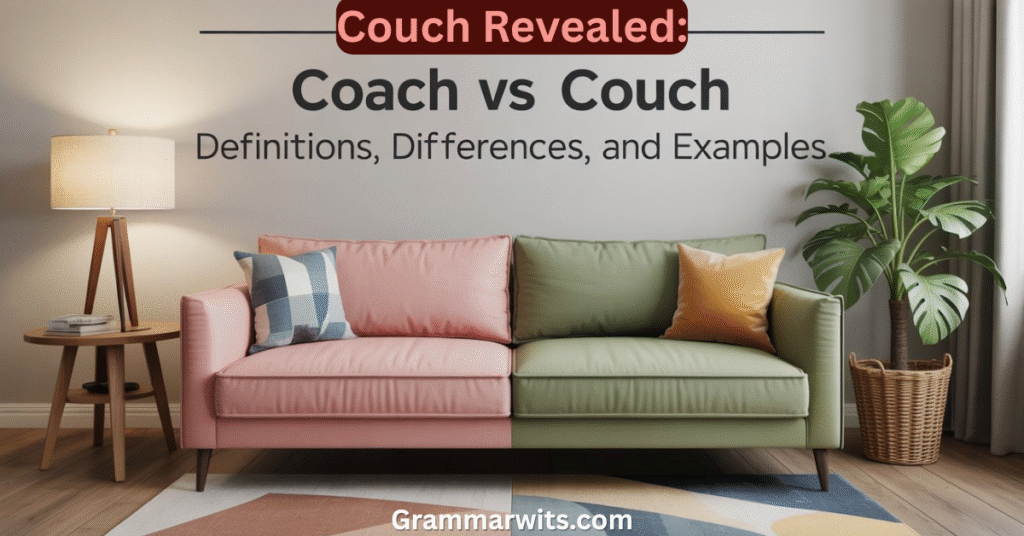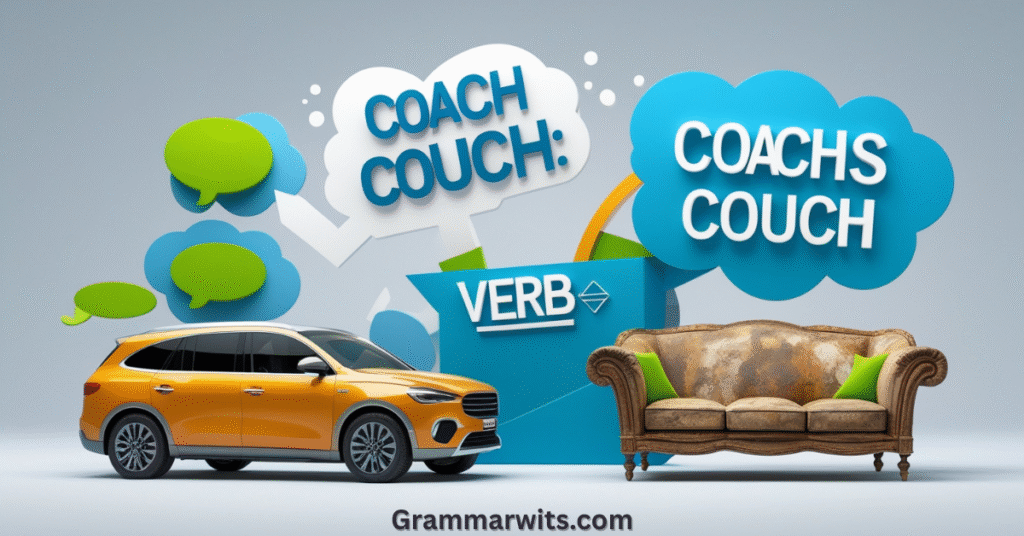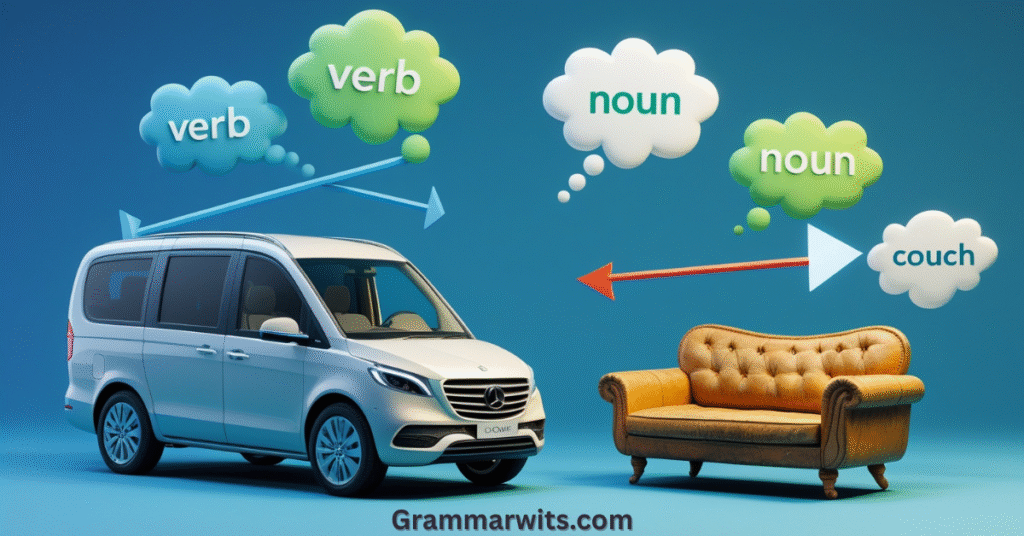“Coach vs Couch” explores two deceptively similar-looking words that have completely different meanings. A coach typically refers to a person who trains, guides, or instructs others—whether in sports, academics, or personal growth. Alternatively, it can describe a type of passenger transport, such as a long-distance bus or a train car. In contrast, a couch is a piece of furniture designed for sitting or reclining, often found in living rooms or lounges. Though spelled almost identically, these words serve entirely different functions in daily life and language.
What makes “coach vs couch” especially intriguing is how often these terms are mixed up—despite the clear difference in meaning. One refers to progress and personal development, while the other symbolizes comfort and relaxation. This subtle mix-up is one of those small linguistic slip-ups that can completely change the tone or intention of a sentence, making this comparison not only educational but also entertaining.
Understanding “coach vs couch” isn’t just about correcting common grammar mistakes; it’s about mastering the nuances of the English language. This guide breaks down everything—from definitions and etymology to usage examples and pronunciation—giving you the confidence to use both words correctly every time. Whether you’re coaching a team or crashing on your couch, this breakdown will stick with you.
Why Smart People Still Get These Wrong
The Coach vs Couch dilemma isn’t about intelligence. It’s about how our brains process similar spelling words. When you’re typing quickly, muscle memory takes over. Your fingers often default to the more familiar word pattern.
Homophones and near-homophones create this exact problem. Research shows that 73% of common spelling errors involve words with only one or two letter differences. Coach and couch fit this pattern perfectly.
Autocorrect makes things worse. Your phone’s keyboard learns your typing habits. If you frequently type “couch” while discussing furniture, it might suggest “couch” when you mean “coach.” This creates a feedback loop of mistakes.
Grammar confusion also plays a role. Both words can function as nouns and verbs, which adds another layer of complexity to the Coach vs Couch puzzle.
The Root of the Confusion: More Than Just Similar Letters

Visual similarity creates the foundation for Coach vs Couch mix-ups. When you scan text quickly, your brain fills in gaps based on expectations. If you’re reading about sports, you expect “coach.” If you’re reading about home decor, you expect “couch.”
The o and a in these words occupy the same visual space. In many fonts, these letters look remarkably similar at small sizes. This similarity tricks your visual processing system.
Common typing errors compound the problem. The a and o keys sit adjacent on most keyboards. A slight finger slip transforms one word into the other. Touch typists especially struggle with this because they rely on muscle memory rather than visual confirmation.
Context clues often fail us with Coach vs Couch scenarios. Consider this sentence: “I need to find a good ___ for my back problems.” Both words could work depending on whether you’re seeking furniture or a trainer.
Coach Decoded: Beyond Sports and Transportation
Primary Definitions
Coach carries multiple meanings across different contexts. As a sports coach, this person develops athletes’ skills and strategies. They analyze performance, create training programs, and motivate teams toward success.
The transportation meaning refers to a large bus designed for long-distance travel. These vehicles offer comfortable seating and amenities for passengers. Coach also describes the economy class section on airplanes, distinguishing it from first-class accommodations.
As a verb, coach meaning involves guiding someone toward improvement. You might coach a colleague through a difficult project or coach a friend through relationship challenges. This definition emphasizes the mentor role rather than formal authority.
The historical coach definition traces back to horse-drawn carriages. These elegant vehicles transported wealthy passengers in comfort and style. This transportation connection bridges the gap between ancient and modern coach meanings.
Modern Usage Variations
Personal development has transformed coaching into a massive industry. Life coaches help clients set goals, overcome obstacles, and achieve personal growth. This field didn’t exist fifty years ago but now generates billions in revenue annually.
Executive coaching serves business leaders seeking to enhance their leadership skills. These facilitators work with C-level executives to improve decision-making, communication, and strategic thinking. Corporate coaching programs have become standard in Fortune 500 companies.
Academic coaching supports students struggling with study habits, time management, or test anxiety. These instructors don’t teach subject matter but instead focus on learning strategies and academic skills. Universities increasingly offer these services to improve retention rates.
Online coaching platforms have democratized access to mentorship. Apps and websites connect coaches with clients worldwide, breaking down geographical barriers that once limited coaching opportunities.
Couch Revealed: More Than Just Furniture

Core Definitions
Couch primarily refers to living room furniture designed for multiple people to sit comfortably. Unlike chairs, couches typically accommodate two to four people and encourage relaxation. They’re central pieces in most home entertainment spaces.
As a verb, couch means to express something diplomatically or carefully. Politicians often couch controversial statements in moderate language. Lawyers couch arguments in legal precedent to strengthen their cases.
Medical contexts use couch to describe examination tables or treatment surfaces. Psychoanalysis famously features the therapist’s couch where patients recline during sessions. This furniture connection bridges medical and psychological treatment settings.
The couch definition also encompasses temporary sleeping arrangements. Couch surfing describes staying on friends’ couches while traveling or during housing transitions. This cultural phenomenon has spawned dedicated websites and communities.
Contemporary Applications
Couch potato culture emerged with television’s rise to prominence. This term describes sedentary individuals who spend excessive time watching TV from their couches. Streaming services have intensified this lifestyle pattern significantly.
Interior design treats couches as anchor pieces that define living room aesthetics. Designers consider size, color, fabric, and style when selecting couch options. The right couch can transform an entire space’s atmosphere and functionality.
Furniture shopping involves complex couch decisions. Buyers must balance comfort, durability, style, and budget constraints. Couch selection often represents one of the largest furniture investments homeowners make.
Casual furniture categories distinguish couches from formal seating options. Couches prioritize comfort and relaxation over ceremonial appearance, making them perfect for family living room environments.
The Definitive Difference Breakdown

Pronunciation Mastery
Coach pronunciation uses the long “o” sound: /koʊtʃ/. Your mouth forms a circular shape, similar to saying “boat” or “coat.” The sound flows smoothly from the vowel to the “ch” ending.
Couch pronunciation employs the “ou” diphthong: /kaʊtʃ/. This sound resembles “cow” or “house,” starting with an “ah” sound and ending with “oo.” Your mouth opens wider initially, then closes for the final sound.
Regional accent variations affect both words differently. Southern American accents might elongate the vowel sounds, while British accents could modify the “ch” ending. However, the fundamental pronunciation difference remains consistent across English language dialects.
Audio memory tricks help cement these pronunciation patterns. Practice saying “coach the boat” and “couch in the house” to reinforce the correct vowel sounds through similar sounding English words.
Visual Recognition Tricks
The spelling difference centers on one crucial letter. Coach contains an “a” that you can associate with “athlete” or “advisor.” Couch contains “ou” that connects to “house” or “lounge.”
Font-based confusion occurs in certain typefaces where “a” and “o” appear nearly identical. Sans-serif fonts at small sizes create the most problems. When in doubt, increase font size or switch to a clearer typeface.
Mnemonic devices provide instant recall solutions. Remember: “Coach has an ‘a’ for Athlete” and “Couch has ‘ou’ like ‘OUch’ when you fall off.” These memory tools work because they create logical associations.
Visual scanning techniques help catch errors before they become embarrassing mistakes. Train yourself to pause briefly when encountering either word during proofreading. This momentary hesitation allows conscious verification of word usage.
Contextual Usage Rules
Coach appears in professional, educational, and transportation contexts. Sports articles, business communications, and travel documents frequently feature this word. The surrounding vocabulary often includes terms like “training,” “strategy,” “guidance,” or “development.”
Couch dominates home, furniture, and lifestyle discussions. Interior design articles, living room descriptions, and comfort-related content typically use this word. Associated vocabulary includes “comfortable,” “relax,” “furniture,” and “home.”
Professional scenarios rarely confuse these words because context provides clear guidance. A business email about hiring a coach wouldn’t make sense with couch substituted. Similarly, furniture catalogs wouldn’t advertise coaches for your living room.
Coach vs Couch clarity improves when you consider the action or object being described. If someone sits or lies on it, choose couch. If someone provides guidance or transportation, choose coach.
Synonym Exploration: Expanding Your Vocabulary Arsenal
Coach Alternatives
Mentor represents the closest coach synonym in personal development contexts. Both words imply guidance and wisdom-sharing, though mentors often have longer-term relationships with their mentees. Mentorship typically involves career or life advice rather than specific skill development.
Trainer focuses on skill-building and conditioning, particularly in fitness and sports contexts. While coaches develop strategy and motivation, trainers concentrate on technical improvement and physical conditioning. Many professional sports coaches also serve as trainers.
Instructor emphasizes teaching and education rather than coaching’s broader guidance role. Instructors deliver structured lessons and curriculum, while coaches adapt their approach to individual needs and circumstances.
Adviser and manager offer guidance in professional settings. Advisers provide recommendations and counsel, while managers direct work activities and team performance. Both roles overlap with coaching but carry different authority structures.
Couch Substitutes
Sofa serves as the most common couch synonym in furniture terminology. British English favors “sofa” while American English uses both terms interchangeably. Furniture retailers often list both words to capture broader search traffic.
Settee represents a more formal seating option, typically smaller and more upright than casual couches. This furniture piece bridges the gap between chairs and full-sized couches, often appearing in entryways or formal living rooms.
Divan describes a backless couch or daybed, often used for lounging or napping. This furniture style originated in Middle Eastern cultures but has found popularity in modern interior design applications.
Loveseat specifically accommodates two people, making it smaller than standard couches. Furniture buyers often choose loveseats for smaller spaces or as accent pieces alongside larger sectional furniture.
Real-World Examples That Stick

Coach in Professional Settings
Business emails frequently reference executive coaching and management coaching programs. “Our company hired a coach to improve leadership skills across all departments.” This usage clearly indicates professional development rather than furniture.
Sports coaching examples dominate athletic contexts. “The coach developed a new strategy for the championship game.” Here, coach functions as both noun and strategic leader, emphasizing the guidance and mentor aspects of the role.
Educational institutions promote academic coaching services. “Students can schedule sessions with a coach to improve study habits.” This example shows coaching expanding beyond sports into personal development territories.
Transportation examples appear in travel contexts. “We booked a coach for the cross-country trip.” This usage clearly refers to vehicle transportation rather than any form of guidance or mentorship.
Couch in Daily Life
Furniture shopping scenarios frequently mention couches. “We need a new couch for the living room renovation.” This example establishes clear furniture context that wouldn’t make sense with coach substituted.
Lifestyle discussions often feature couch references. “I spent the weekend as a couch potato indulge-watching series.” This cultural reference specifically requires couch to maintain its intended meaning about sedentary behavior.
Interior design contexts regularly include couch selections. “The designer recommended a sectional couch to maximize seating in the small space.” Here, couch functions as essential living room furniture rather than any guidance role.
Medical settings sometimes reference examination couches. “Please lie on the couch for your physical therapy session.” This usage bridges furniture and medical treatment contexts, showing couch’s versatility beyond home furniture.
The Fascinating Origins: Etymology Deep Dive
Coach’s Journey Through Time
Coach etymology traces to the Hungarian town of Kocs, where skilled craftsmen built superior horse-drawn vehicles in the 15th century. These “kocsi” carriages became famous throughout Europe for their comfort and durability.
The transportation meaning evolved as these vehicles spread across continents. By the 1800s, coach described any four-wheeled passenger vehicle, from elegant carriages to public stagecoaches. This established the foundation for modern coach transportation terminology.
Sports coaching emerged in the 1840s at British universities. Students used coach metaphorically, comparing their tutors to vehicle drivers who helped them “reach their destination” academically. This clever wordplay transformed transportation vocabulary into educational terminology.
Modern coaching industry explosion occurred in the late 20th century. Personal development coaches, life coaches, and executive coaching programs proliferated as people sought guidance outside traditional therapy or mentorship structures.
Couch’s Surprising History

Couch etymology stems from the French word “coucher,” meaning “to lie down.” This verb connection explains why couches emphasize relaxation and reclining furniture rather than formal seating positions.
Medieval furniture evolution transformed simple sleeping mats into elaborate couches. Wealthy households commissioned ornate couches for receiving guests and displaying status. These pieces combined function with artistic expression.
Psychoanalysis adopted couches in the late 1800s when Freud established his famous treatment method. Patients reclining on couches became synonymous with psychological therapy, creating lasting cultural associations between couches and mental health treatment.
Modern furniture design revolutionized couch construction with new materials and manufacturing techniques. Sectional couches, convertible furniture, and ergonomic designs expanded couch functionality beyond simple seating arrangements.
Memory Tricks That Actually Work
Foolproof Mnemonics
“Coach has an ‘a’ for Athlete” provides instant Coach vs Couch clarification. This mnemonic device creates a logical connection between the letter and the sports coach meaning. The association strengthens through repetition.
“Couch has ‘ou’ like ‘OUch’ when you fall off” offers a memorable couch identification system. This silly but effective memory trick connects the spelling pattern to physical experience everyone can relate to.
Visual association techniques work by linking spelling differences to memorable images. Picture a coach standing next to an athlete (both contain “a”) and a couch in your house (both contain “ou” sounds).
Contextual memory anchors help by associating each word with its most common usage patterns. Coach connects to movement, guidance, and transportation. Couch links to furniture, relaxation, and home comfort.
Quick Reference Checklist
Context verification methods prevent Coach vs Couch errors before they happen. Ask yourself: “Does this involve guidance, transportation, or sports?” If yes, choose coach. “Does this involve furniture, relaxation, or home?” If yes, choose couch.
Spell-check bypass strategies help because standard spell-check software recognizes both words as correct. Manual verification becomes essential. Read sentences aloud, substituting obvious synonyms to test meaning.
Professional writing safeguards include using find-and-replace functions to highlight both words during editing. This technique forces conscious evaluation of each instance rather than relying on automatic recognition.
Team review processes catch errors that individual writers miss. Having colleagues review important documents provides fresh eyes that spot Coach vs Couch mix-ups and other common spelling errors.
Common Mistakes to Avoid Forever
Autocorrect Traps
Phone keyboards create unique Coach vs Couch challenges because predictive text learns from your usage patterns. If you frequently discuss furniture, your phone might suggest “couch” when you mean “coach.”
Training your devices requires conscious correction of autocorrect mistakes. When your phone suggests the wrong word, manually type the correct version and select it. This teaches your device your preferred usage patterns.
Professional email disasters occur when autocorrect changes coach to couch in business communications. “We hired a couch for leadership training” sounds absurd and unprofessional. Always proofread important messages before sending.
Social media embarrassments multiply quickly when followers notice Coach vs Couch mistakes. These errors can damage credibility, especially for coaches, trainers, and furniture retailers who should know the difference.
Writing Pitfalls
Formal document mix-ups carry serious consequences in academic and professional settings. Resume mistakes like “life couch” instead of “life coach” can eliminate job candidates from consideration immediately.
Cover letter dangers include Coach vs Couch errors that reveal carelessness rather than simple typos. Hiring managers notice these mistakes because they suggest poor attention to detail and lack of proofreading.
Academic paper confusion damages scholarly credibility. Research papers discussing coaching methodologies or furniture design must maintain terminological accuracy throughout to preserve academic integrity.
Marketing materials require perfect Coach vs Couch accuracy because errors multiply across thousands of copies. Advertising campaigns with these mistakes waste money and damage brand reputation significantly.
Your New Confidence in Word Choice
Key takeaways for instant Coach vs Couch recall center on pronunciation, context, and visual cues. Remember the “a” for athlete in coach and the “ou” sound like “house” in couch. These simple associations prevent confusion permanently.
Practice opportunities exist in daily writing and conversation. Challenge yourself to notice both words in articles, emails, and social media posts. This conscious attention builds automatic recognition skills over time.
Moving forward with certainty means trusting your new knowledge while maintaining healthy skepticism. When in doubt, pause and apply the verification techniques you’ve learned. Confidence comes from preparation, not assumption.
The Coach vs Couch distinction becomes second nature with consistent application. Soon you’ll catch others’ mistakes and help them avoid these common spelling errors. Your improved English vocabulary skills benefit all your writing endeavors.
FAQs: The Questions Everyone Asks
What’s the easiest way to remember the difference?
The simplest Coach vs Couch memory trick uses letter associations. Coach contains “a” like “athlete” – think sports coaching or guidance. Couch contains “ou” like “house” – think furniture and home comfort. This method works because it connects spelling differences to meaning through logical associations.
Do these words have different meanings in other English-speaking countries?
British English and American English handle Coach vs Couch similarly, though British speakers often prefer “sofa” over “couch” for furniture. Australian and Canadian English follow American patterns closely. The pronunciation and core definitions remain consistent across all major English language variants worldwide.
Which word is more commonly misspelled?
Coach gets misspelled as “couch” more frequently than the reverse, particularly in sports coaching and business coaching contexts. This happens because couch appears more often in casual writing, making it the default pattern for many typists. Professional contexts require coach, but muscle memory defaults to couch.
Are there any other word pairs that cause similar confusion?
Yes, several similar spelling words create comparable problems. Principal vs principle, affect vs effect, and complement vs compliment share the same one-letter difference pattern. These homophones and near-homophones challenge writers because spell-check software accepts both versions as correct, requiring manual verification.
How can I help my kids avoid this common mistake?
Teaching children Coach vs Couch differences works best through visual and contextual methods. Create flashcards showing a sports coach next to the word coach and living room furniture next to couch. Practice with simple sentences and encourage reading aloud to reinforce pronunciation differences. Make it fun with games and positive reinforcement rather than focusing on mistakes.

Alizy Smith is a passionate language enthusiast and the admin of Grammar Wits. With a love for wordplay, grammar quirks, and witty expressions, she’s dedicated to making language learning fun and accessible. From grammar tips to pun-filled laughs, Alizy ensures every piece of content entertains while educating — turning tricky rules into easy, enjoyable reads.





